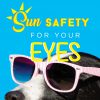Did you know that sunglasses can do more than make you look cool and dim down the light?
Most people understand the damage the sun can wreak on the skin, and how to protect oneself, but your eyes are also vulnerable to the UV rays, and there are measures you can take to protect them. In fact, your eyes are the only internal tissue exposed to UV (ultraviolet) rays. There are three main types of UV rays, but two in particular to be wary about: UVA rays and UVB rays.
According to Mayo Clinic, “UV radiation from the sun can damage not only the skin of your eyelid but also the cornea, lens and other parts of the eye. UV exposure also contributes to the development of certain types of cataracts, growths on the eye, and possibly macular degeneration.”
Sunglasses can also provide protection from skin cancer. Eye Site on Wellness writes that the eyelid region is a common area for skin cancers such as basal cell carcinoma, squamous cell carcinoma, and melanoma. These skin cancers of the eyelid account for five to ten percent of all skin cancers in the US.
While it’s crucial for people of all ages to protect their eyes from sunlight, children and senior adults with eye conditions face the highest risk. If you (or someone you love) have an eye condition like cataracts, retinal disease, and macular degeneration, then your eyes will be especially at-risk and susceptible to UV rays.
Contrary to popular belief, the color and darkness of the sunglass lenses have nothing to do with the actual protection the glasses provide.
When shopping for sunglasses, keep these tips in mind:
• Consider wraparound sunglasses that shield your eyes even on the sides.
• Not all polarized sunglasses offer UV protection, so don’t conflate the two! However, many shades do offer both benefits.
• Look for shades that are UV400 or higher.
The American Optometric Association advises that your sunglasses should:
• block out 99 to 100 percent of both UV-A and UV-B radiation;
• screen out 75 to 90 percent of visible light;
• have lenses that are perfectly matched in color and free of distortion and imperfection; and
• have lenses that are gray for proper color recognition.

In addition, remember that even in the shade, it’s important to protect oneself from the UV rays that reflect off of buildings or other shiny surfaces around.
If you spend time outdoors and are concerned about the amount of protection your sunglasses offer, then speak with an ophthalmologist. Many eye care professionals have tools that can measure the degree of UV protection your sunglasses have, and will be able to offer some suggestions if your current pair doesn’t suffice.
It’s crucial to think of sunglasses in a similar way to sunscreen. Protect your skin, but don’t forget your eyes!
If you found an error, highlight it and press Shift + Enter or click here to inform us.



